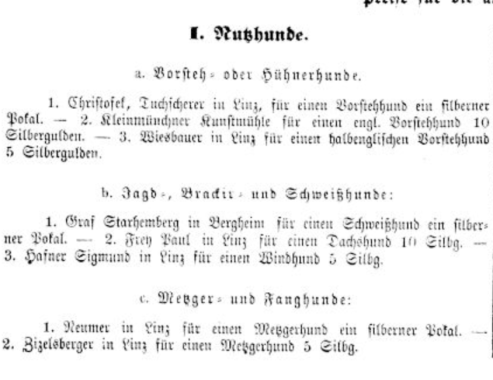
“Das Becken von Linz mit der Landeshauptstadt” by Eduard Zetsche (1844-1927) from the book “Die österreichisch-ungarische Monarchie in Wort und Bild”, Band Oberösterreich und Salzburg, Wien 1886, Page 17
My Great-great-great-Greatuncle Paul Wiesinger was born on 28. June 1832 in the capital of Upper Austria, Linz, in the parish of St. Mathias. He was the son of the unmarried Josepha Wiesinger, “daughter of a house owner“.
In the baptismal book, no father is indicated, but the godfather, Philipp Klimitsch, a “master brewer in Auhof 1” is interesting, as I could not find any other connection to him. This might be a clue for Paul’s father.
By the way, Auhof is a manor in Linz which was owned by the family Starhemberg. The brewery was under lease in 1832 and was demolished in 1900 (Source: Wikipedia, Entry for Schloß Aufhof (Linz))
Paul’s mother Josepha married Ferdinand Mathias Frey in 1837. Due to this marriage, Paul was referred to as Paul Frey in later documents. The couple had no other children and in March 1863, Josepha Frey died aged 59.
Several months later, on 15.November 1863, Paul (then aged 31) married 39-year-old Juliana Bruckmüller, a maid and the daughter of the master miller Johann Bruckmüller from the “Grubmühle” in Thal. This can be seen in the Marriage Consent Book of the City of Linz as well as from the Marriage Book of the parish of St.Mathias.




„Austria, Upper Austria, Linz, Selected Documents of the Federal State Archive 1485-1894,” images, FamilySearch (accessed 22 May 2014), Ehekonsens-Protokoll 1850-1868 > image 416 of 517; (Upper Austiran State Archives, Linz).
(Translation: “Name of the groom”-“Paul Wiesinger also known as Frey”, “Born on”-“Linz, 28.1.1832”, “Profession”-“authorized Musician”, “Marriage Status”-“single” and “Domicile”-“Linz 1057”
“Name of the Bride”-“Juliana Bruckmüller”, “Born on”-“Sigharding, 18.6.1824”, “Domicile”-“Linz 1055”, “Note” contains file number)
The profession of Paul Wiesinger is authorized musician which is interesting. The couple seems to have been neighbors, as their addresses are Linz 1055 and 1057.
The entry in the marriage book basically gives the same information as stated above. The witnesses to the marriage are interesting:
- Johann Hofmeister, piano maeker in Bethlehemgasse 44
- Simon Danzmayr, musician
I do not have any clue which instrument Paul Wiesinger played, but it could have been the piano!

On 16.September 1865 the only child of the couple was born, a daughter named Franziska. At the time of birth, the family was obviously renting rooms/a flat in the house of the carpenters Großpointner in Schulerberggasse 945 in Linz. Franziska Großpointner was the godmother of the child.
Sadly, the baby died 18 days later as she was “too weak to live”.
On 12.February 1867 Paul’s stepfather Ferdinand Frey died of Tuberculosis at the age of 64 years.
Paul Wiesinger is mentioned twice in the newspapers (“Linzer Tagespost”). However, this is not in context with his profession, but relates to dogs:

At the occasion of a fair in Linz in 1865, Paul Wiesinger/Frey won second place in the category “Hounds and Bloodhounds” („Jagd-, Schweiß und Brackirhunde“) with a Dachshund. (The Count of Graf Starhemberg won the first place).

From the book “Meyers Kleines Konversations-Lexikon”, Seventh Edition, Leipzig and Vienna, 1909; Entry “Hunde”
Possibly Paul Wiesinger was a dog breeder or a huntsman which could also be related to the breeding of hounds. However, I could not find any indication in that context.
In 1882, the following was published:
Thus, Paul Wiesinger also won a price for his dogs in 1881. His address at that time was Donatusgasse in Linz.
Only some moths after the advertisement above was published, Paul Wiesinger died on 25.July1883 due to Tuberculosis at the age of 51. His wife Juliana died four years later on 7.March 1887 aged 61 from senility (“old age”).
By the way, as I realized when writing this post, there is clear message here: Additional information such as witnesses of births or marriages can contain valuable clues for family history research.

![By Artist: A. Sandoz Engraver: John Outhwaite (Old Prints and Antique Engravings) [Public domain], via Wikimedia Commons](https://schatzkistedotblog.files.wordpress.com/2017/06/schlachtvondurnstein1805.png?w=438&h=319)
![Napoléon dans son cabinet de travail von Jacques-Louis David 1812, [Public domain], via Wikimedia Commons](https://schatzkistedotblog.files.wordpress.com/2017/06/napoleon-jacques-louis_david_-_the_emperor_napoleon_in_his_study_at_the_tuileries_-_google_art_project.jpg?w=210&h=350)
















